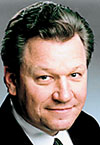By Will Hoover
Advertiser Staff Writer
 |
| BRADLEY: Co-author of "Flags of Our Fathers" |
| Pacific War Memorial Association Benefit dinner with guest James Bradley, author of "Flags of Our Fathers"
Reception, dinner, Bradley address and book signing
6-10 p.m. Friday
Tapa Ballroom, Hilton Hawaiian Village
$100
Reservations: 422-9404 (by 5 p.m. today) |
Last May, "Flags of Our Fathers" landed on the New York Times best-seller list, where it remains.
Tomorrow, the book’s author, James Bradley, will land in Honolulu, where he will do his part to raise $600,000 for an Iwo Jima Memorial expected to grace the entrance of Marine Corps Base Hawai‘i in Kane‘ohe.
Today, Bradley is on Iwo Jima, an eight-square-mile speck of land 660 miles south of Tokyo, where, on Feb. 23, 1945, Bradley’s father and five other soldiers raised the American flag and inadvertently achieved immortality.
"The flag-raising photo at Iwo Jima is the most reproduced photograph ever taken," said Bradley, speaking from his home in Rye, N.Y., shortly before leaving for a second visit to Iwo Jima. But while most everyone has seen Joe Rosenthal’s Pulitzer Prize-winning picture, the soldiers in it were virtually unknown. One, Ira Hayes, was the subject of folk songs and movies, but the others were mystery heroes.
Bradley said Pearl Harbor did more than usher the United States into World War II. It introduced the "two-ocean war."
"Against Japan," writes Bradley, "America would stand virtually alone in the Pacific. . . . The Pacific would be ‘America’s War.’"
Iwo Jima was the first Japanese soil invaded by Americans in World War II. The Marines involved were trained in Hawai‘i.
"They were told, ‘This will probably be a three-day battle,’" said Bradley. "‘There’s no potable water and we can’t see anybody on the island.’ Well, the Japanese weren’t in foxholes. They were in a secret underground city made up of 16 miles of tunnels connecting 1,500 rooms."
Iwo Jima turned out to be the bloodiest battle in Marine Corps history. When the smoke finally cleared, 7,000 Americans and 20,000 Japanese were dead. Three of the six soldiers pictured in Rosenthal’s photo did not leave the island alive.
The famous photo galvanized the nation in the final grueling months of World War II. President Harry Truman ordered 4 million Iwo Jima flag-raising posters to be distributed throughout country to promote war bonds.
To many, the photo not only represented America’s conflict in the Pacific, but the entire war.
Yet, said retired Marine Corps Gen. Dick Vercauteren, who is on the board of the Pacific War Memorial Association, "There is nothing in the Pacific pertaining to that event" - no memorial or plaque of any kind.
The association plans to correct that oversight by erecting a statue based on the Rosenthal photo at the entrance of the Marine base in Kane‘ohe. "Our goal is to dedicate this memorial next year on the anniversary of the flag-raising at Iwo Jima," said Vercauteren.
To assist, Bradley will give a speech and sign books at a $100-a-plate dinner Friday evening at the Hilton Hawaiian Village.
But Bradley, who wrote "Flags of Our Fathers" with Pulitzer Prize-winning writer Ron Powers, didn’t hear the story from his father.
"My dad didn’t talk," he said.
There wasn’t even a copy of the photograph in the Bradley home.
John Bradley was the last of the six to die and the only Navy corpsman among the flag-raisers. His son says his dad politely demurred whenever the subject of Iwo Jima came up. In the 47 years of his life after the battle, he granted one interview, at his wife’s insistence. Even then, he offered almost nothing. It wasn’t until after his death in 1994 that his family learned he had been awarded the Navy Cross for valor at Iwo Jima.
But then came an even bigger surprise.
"After my dad died in 1994, my brother opened his closet door and found three cardboard boxes full of stuff."
The boxes were crammed with a half-century of letters and documents pertaining to Iwo Jima, including such curiosities as an autograph request from John Wayne.
"What got me going was, in the bottom of one box, I found the letter my dad wrote to his parents three days after the flag-raising. He was still on Iwo Jima and the battle was raging. And he writes that the flag-raising was the happiest moment of his life.
"Well, I cried and cried when I read that. This was a nonevent that Dad never wanted to talk about. But as a boy, it was the happiest moment of his life. There was a mystery here to me.
"So, I picked up the phone and started calling people."
Four years and many miles and interviews later, Bradley had compiled a powerful and compelling account of six "everyday heroes" - Ira Hayes, Michael Strank, Harlon Block, Rene Gagnon, Franklin Sousley and John Bradley.
Three of them died in battle, two lived tragic lives, and one, Bradley’s dad, lived a relatively normal lifestyle, partly because he shut Iwo Jima out of his life, concludes Bradley.
His son believes that "Doc" Bradley made a conscious decision to dismiss the memories - the unimaginable horror he witnessed as a young hospital corpsman, tending to the wounds of mutilated and dying fellow troops, and then being severely wounded in both legs himself. The senior Bradley went to his grave bearing shrapnel from Iwo Jima.
The real heroes, Bradley’s dad insisted in one of the rare moments he ever spoke of Iwo Jima, were the ones who didn’t come home.
"The point of the book is that these six people were just ordinary guys," said Bradley. "What I wanted to do was de-mystify them. They were just ordinary guys doing their duty - and that is the crux of heroism."
[back to top] |

 The Great Index to Fun
The Great Index to Fun